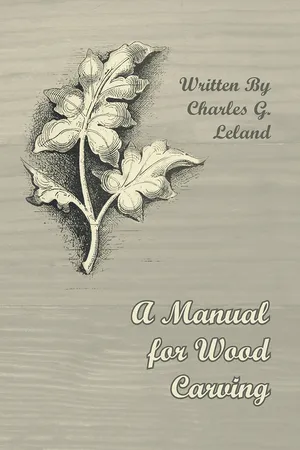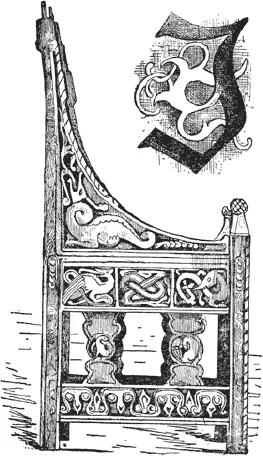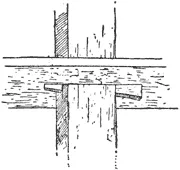
- 214 pages
- English
- ePUB (mobile friendly)
- Available on iOS & Android
eBook - ePub
A Manual for Wood Carving
About this book
This book contains a detailed guide to manual wood carving, including information on tools, materials, and technique. Complete with simple, step-by-step instructions and detailed illustrations and diagrams, this text is ideal for those with little or no experience and makes for an invaluable addition to collections of woodworking literature. The chapters of this book include: Woods, Tools, and Sharpening; Indenting and Stamping; Cutting Grooves with a Gouge; Flat Patterns made with Cuts and Lines; Cutting out a Flat Panel with a Ground; Cutting Simple Leaves - Carving with the Left Hand - Modelling or Rounding - Shaded Patterns and Modelling - Progress Towards Relief; and much more. This text has been elected for modern republication due to the timeless nature of the lessons contained within, and we are proud to republish it now complete with a new introduction on decorative Woodwork.
Frequently asked questions
Yes, you can cancel anytime from the Subscription tab in your account settings on the Perlego website. Your subscription will stay active until the end of your current billing period. Learn how to cancel your subscription.
At the moment all of our mobile-responsive ePub books are available to download via the app. Most of our PDFs are also available to download and we're working on making the final remaining ones downloadable now. Learn more here.
Perlego offers two plans: Essential and Complete
- Essential is ideal for learners and professionals who enjoy exploring a wide range of subjects. Access the Essential Library with 800,000+ trusted titles and best-sellers across business, personal growth, and the humanities. Includes unlimited reading time and Standard Read Aloud voice.
- Complete: Perfect for advanced learners and researchers needing full, unrestricted access. Unlock 1.4M+ books across hundreds of subjects, including academic and specialized titles. The Complete Plan also includes advanced features like Premium Read Aloud and Research Assistant.
We are an online textbook subscription service, where you can get access to an entire online library for less than the price of a single book per month. With over 1 million books across 1000+ topics, we’ve got you covered! Learn more here.
Look out for the read-aloud symbol on your next book to see if you can listen to it. The read-aloud tool reads text aloud for you, highlighting the text as it is being read. You can pause it, speed it up and slow it down. Learn more here.
Yes! You can use the Perlego app on both iOS or Android devices to read anytime, anywhere — even offline. Perfect for commutes or when you’re on the go.
Please note we cannot support devices running on iOS 13 and Android 7 or earlier. Learn more about using the app.
Please note we cannot support devices running on iOS 13 and Android 7 or earlier. Learn more about using the app.
Yes, you can access A Manual for Wood Carving by Charles G. Leland in PDF and/or ePUB format. We have over one million books available in our catalogue for you to explore.
Information
eBook ISBN
9781473360693Subtopic
Technical & Manufacturing TradesAPPENDIX.
OBJECTS FOR WOOD-CARVING.
“The most difficult part of making is to know what to make.”

Fig. 64.
In no circumstances should the wood-carver be at a loss for a subject to work on, yet this is the commonest source of complaint, especially among young artists, that they “do not know what to take up.” One result of this is the wearisome production of panels or “fancy pieces” without any definite aim, and a constant imitation of one another’s work. Unfortunately there are a great many who cannot understand or form any idea how a pattern would look when executed. They will pass it over in an engraving, but when they see it actually carved and made up they appreciate it. Now the tutor should teach the pupils, and the students teach themselves, to think of subjects, to invent them, to sketch and execute them. I have found that all workers are invariably more defective in this respect than in any other, and that it is one in which the direction of almost every art school in the world is either utterly wanting, or else leaves much to be desired.
Pupils should be encouraged to look at every object with an eye to ornamenting or decorating it, so far as that can be done without detracting from its usefulness. In every school a list of objects for carving should be hung up, and the workers be frequently requested to think of subjects to add to the list; outline sketches of furniture and other objects should be supplied. It is not at all understood that even a very little frequent employment of the mind inventing and planning, no matter at what, stimulates all the mental faculties to an extraordinary degree.
I therefore seriously urge that the wood-carver shall earnestly study the following list of subjects, add to it, and at times take one or the other of them and sketch it with variations. He may remember while doing this, that any of the ornaments given may be varied and applied to different things, as, for instance, the vine on a circular panel may be easily adapted to a square. Full directions for doing this may be found in “The Manual of Design,” price one shilling, which also contains many patterns perfectly adapted to carving.
The first subject to be considered is: What to design or make; how its surface can be appropriately ornamented; and, how to produce the best effect with the least work. Mere elaboration is admired only by the ignorant, and the less cultivated a pupil is, the more inclined he will be to densely crowded petty patterns.
If the pupil wants a design for any of the objects described in this chapter, and if he can draw at all, and has any skill in adapting or changing a pattern, as, for instance, to make one which fills a triangle or a square “set” into a circle, or extend to a long panel or a border, he will find something for any of them, either in this book, or in the “Manual of Design” already referred to. Let him also take pains to collect as many patterns as he can of all kinds, and keep them in a portfolio for reference.
Every student of wood-carving should remember that if he has a folding looking-glass, which he can make for himself by cutting in two a square mirror of, say, six inches by twelve, he can, out of any pattern in this book, or from any simple ornament whatever, make (with the least effort of ingenuity or adaptiveness) a border by repeating it in succession, or a centre ornament which may be multiplied in whole or in part ad infinitum. That is to say, he can fill any given space, be it a panel, ceiling, circle, triangle, or hexagon. Or he can fill such spaces by simply cutting out ornaments from card-board, and placing them together to form vines or outgrowths from one another.
Panels. A panel is defined as a board with a surrounding frame. The word is derived from the old English panel, a piece of cloth, Latin pannus, “a cloth or patch”; from the same word we have pane. In wood-carving we practically apply it to small boards intended to be set in furniture, or walls, or ceilings, or made into book-covers or box-lids. The uses of panels are without limit, as they may be introduced into almost every kind of furniture, such as the backs and sides of chairs, chests, bedsteads, caskets, window-garden boxes, doors, or wherever a flat surface can be adorned. When surrounded with a frame or several strips of moulding, any panel becomes improved when the outer frame is not overdone. As a rule the border of a panel should be plain, so as to distinctly define or set forth the pattern. For this reason many very ordinary and even rude subjects “come out” or look well when thus “mounted.” A series of carved panels makes a beautiful frieze for any room. A good general size for most work is a panel six inches by twelve, more or less, and half an inch thick. In spacing a panel for ornament the pupil may begin by making one circle in the centre and one in each corner, so that the five may fill up the whole space. Convert these into a vine and apply ornaments. There are of course endless variations of this principle. (Consult the “Manual of Design.”)
Chairs. Take any chair, copy it, and then fill the spaces with ornaments to be carved. Large, square, high-backed, old-fashioned chairs admit of the most panelling, and can be made up by any cabinet-maker or carpenter, vide Fig. 69. It is a very good plan to always have such objects made up in pieces, carve them separately, and then have them put together. It may be observed for beginners, and those who are not much practised in cabinet-making, that there is a very substantial kind of furniture once made very commonly in Germany, and which has been much revived of late years. It is made entirely without glue, nails, or screws, by simply cutting holes into which tenons or ends project, which ends are fastened on the other side by holes and pins.

Fig. 65.
On this principle every kind of furniture can be made by any man who is ingenious enough to simply measure boards, cut square holes, and adapt pins to them. Such articles as are made by this process are very much stronger than any others, and they have the great advantage that they can be easily taken apart, packed, or be stored in very small space when not in use; and the style is of course more adapted to carving than ordinary furniture. The writer has in his possession chairs 250 years old made on this principle. The seat is a square nearly two inches thick, in which four ho...
Table of contents
- A MANUAL OF WOODCARVING
- Woodworking
- Decorative Woodwork
- INTRODUCTION.
- FIRST LESSON.
- SECOND LESSON.
- THIRD LESSON.
- FOURTH LESSON.
- FIFTH LESSON.
- SIXTH LESSON.
- SEVENTH LESSON.
- EIGHTH LESSON.
- NINTH LESSON.
- TENTH LESSON.
- ELEVENTH LESSON.
- TWELFTH LESSON.
- THIRTEENTH LESSON.
- APPENDIX TO LESSON XIII.
- FOURTEENTH LESSON.
- FIFTEENTH LESSON.
- SIXTEENTH LESSON.
- SEVENTEENTH LESSON.
- EIGHTEENTH LESSON.
- NINETEENTH LESSON.
- TWENTIETH LESSON.
- APPENDIX.